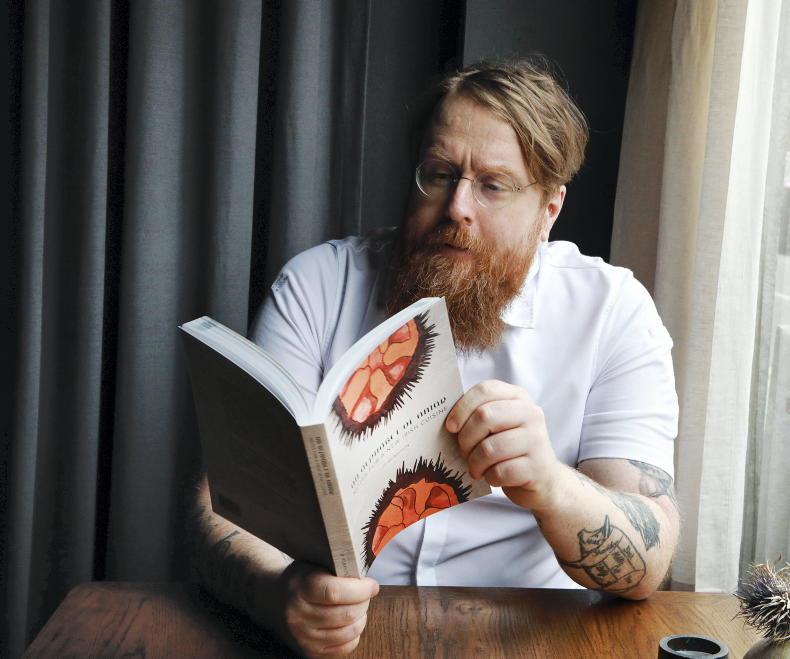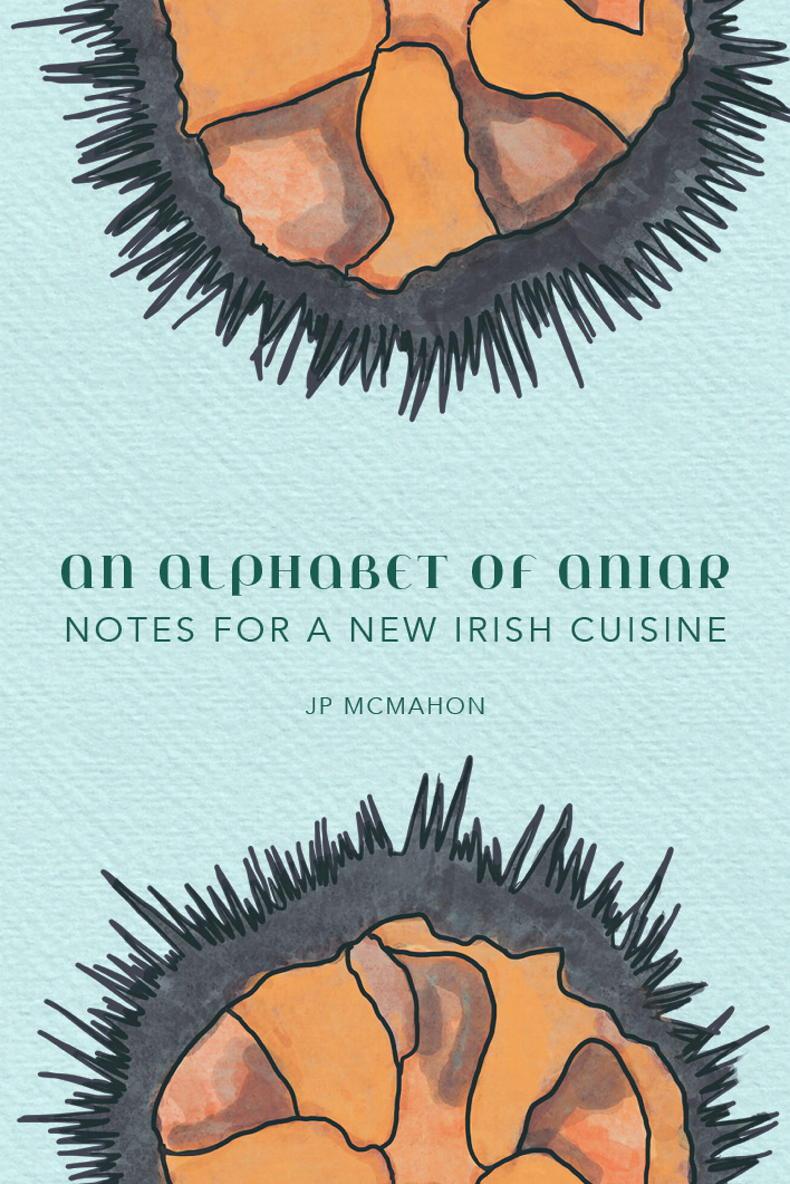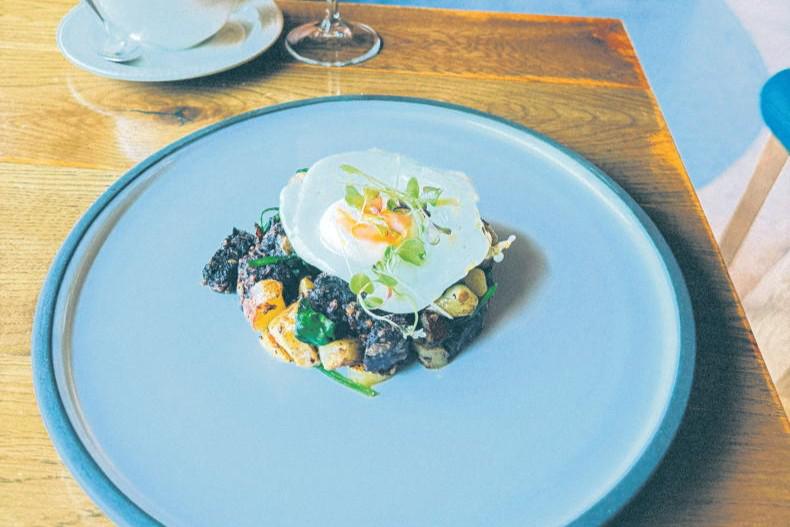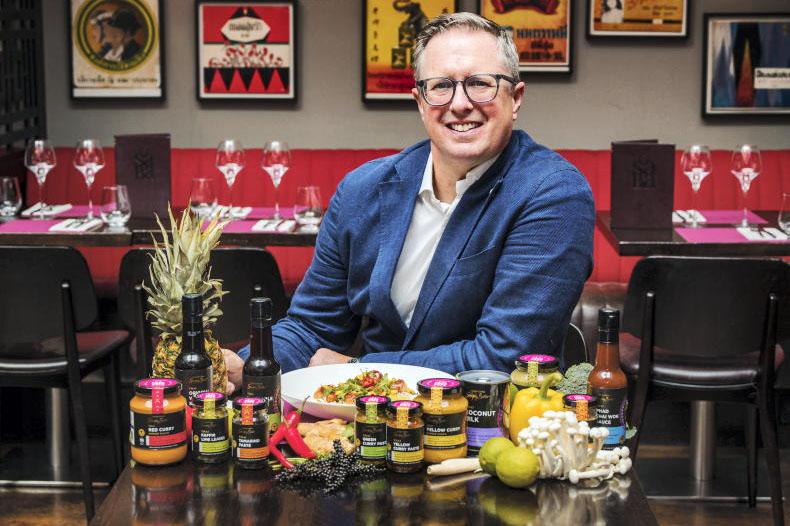“Before Aniar, if someone asked: is there a market for modern Irish cuisine? Or, before Food on the Edge, if someone asked: is there a market for a national food symposium that brings in chefs from all over the world? Everyone would have said ‘no’. You create the market. You win some and you lose some, but that’s all part of it.”
I’m sitting with Michelin-starred chef, entrepreneur and author, Dr JP McMahon, at one of the tables in his Galway restaurant, Aniar. It’s 11am – the restaurant is dimly lit and quiet, and in the kitchen the chefs are prepping for the evening’s dinner service. Just a bit earlier, a pallet was delivered containing 500 copies of JP’s new book, An Alphabet of Aniar.

JP McMahon owns and operates Aniar, Eat at Massimo's and Cava - all restaurants located in Galway City. / Sean Lydon
“I’d been working on this on and off since 2018,” he says. “Just after COVID hit, I felt – you know – the restaurant is 12 years old. Irish food is maturing to a certain degree. I thought it would be nice to draw a line in the sand and look at what we have accomplished, and also consider how we might pass what we have learned on to the next generation of young chefs.
“When we started in 2011, there was no roadmap [within modern Irish gastronomy],” he adds. “We were making it all up as we went along. The book is a road map, to a certain degree, about how you can think about Irish cuisine.”
Companion book
Starting at A and ending at Z, the book reads more manifesto or encyclopaedia than cookbook.
JP says it is meant to serve as a companion to his first book, which was published in 2020 (The Irish Cookbook).
“Because it was written over a long period of time, the book is broken up into what I call ‘notes,’” he explains. “You can pick it up and open to any page. The tone of voice changes a bit; some notes are reflective, but I also tried to put in more abstract ones, like [H for Humility], because I wanted someone from an entirely different industry to be able to pick it up and relate it to their experience.”
Many of JP’s ‘notes’ were influenced by the changes brought about by the COVID-19 pandemic. We know the pandemic accelerated certain things, like online shopping and remote working, but it also changed the way we think and feel about our lives. The restaurant industry has always been fast-paced, low-paid and highly stressful. But does it have to continue this way?
“They say it takes 21 days to break a habit and we had, like, two years,” JP says. “So habits were well and truly broken. It brought up questions like, ‘What am I doing this for, and where is it bringing me?’ Pre-COVID, it was all, ‘This has to be done’. It was almost militaristic. I think these types of progressive changes are something younger generations want, so this is going to lead to a meeting of the minds.”
What is Irish food?
Aside from Aniar, JP also operates Cava Restaurant in Galway city. Until recently, he ran a third restaurant, Tartare, but its closure was announced in August 2022 – a result of rising energy and overhead costs, among other things.
In 2015, he founded Food on the Edge, an Irish food symposium that takes place each October. Aniar was awarded its Michelin star in 2012 and has maintained it ever since. The 30-seat restaurant was widely lauded for championing native Irish ingredients, like seaweed, at a time when we didn’t fully appreciate them. Now, this approach to Irish cuisine is becoming the norm. JP feels the answer to the question ‘What is Irish food?’ is one that will continue to unfold in the coming years.
“Modern Irish gastronomy can only continue to grow,” he says. “It is going to filter down to the places you’ll encounter every day – cafes, coffee shops, bakeries. We need to understand where we’re coming from and we need to appreciate our [native] foods, but we also have other ways to think about Irish food, and people can draw on both of them. Aniar is not the only way to do Irish food. Modern Irish food is more of a process; it’s not something that’s been concluded.”
He applauds the growing diversity of rural Ireland and the effects immigration is having on our food culture; praising the likes of chef Takashi Miyazaki in Cork, who has introduced skilful Japanese technique to native Irish ingredients. These are the kinds of global influences we can bring into the wider Irish food story.
Be louder
“We need to keep trying to sing a bit louder about our ingredients,” JP says. “When we first opened [Aniar], people were like, ‘What are you trying to do?’ or ‘Could you not do steak?’ It took a lot of soul searching on our part because there were times [in those first years] when things were really quiet. If it wasn’t for Cava [where you could serve up to 250 people per night], Aniar would not have survived; it’s been an absolute labour of love.”

JP McMahon has just released his new book, An Alphabet of Aniar.
I ask JP if guests at Aniar are Irish, or if they are coming from elsewhere. He provides this analogy in response:
“We had 24 people booked in a while back, and it was 22 Americans, one Canadian and an Irish guy - and the Irish guy was in eating by himself. That’s a very true representation of how it usually is [at Aniar].”
The unknown
Like farmers, independent restaurant owners need to consider their future – retirement, succession (if possible) and how long they can feasibly continue. JP says restaurants are reminiscent of the times they find themselves in – they naturally wax and wane in popularity; and they come and go, as a result. With two teenaged daughters, he is realistic about the future and isn’t sure whether there will be someone to someday take over his businesses.
“I’d like to keep it going as long as I can – it’s a way of life. Like a child, it’s a seven day a week thing.
“It’s something you just get used to living with.”
JP’s new book An Alphabet of Aniar (€25) is available to purchase online at aniarrestaurant.ie
“Before Aniar, if someone asked: is there a market for modern Irish cuisine? Or, before Food on the Edge, if someone asked: is there a market for a national food symposium that brings in chefs from all over the world? Everyone would have said ‘no’. You create the market. You win some and you lose some, but that’s all part of it.”
I’m sitting with Michelin-starred chef, entrepreneur and author, Dr JP McMahon, at one of the tables in his Galway restaurant, Aniar. It’s 11am – the restaurant is dimly lit and quiet, and in the kitchen the chefs are prepping for the evening’s dinner service. Just a bit earlier, a pallet was delivered containing 500 copies of JP’s new book, An Alphabet of Aniar.

JP McMahon owns and operates Aniar, Eat at Massimo's and Cava - all restaurants located in Galway City. / Sean Lydon
“I’d been working on this on and off since 2018,” he says. “Just after COVID hit, I felt – you know – the restaurant is 12 years old. Irish food is maturing to a certain degree. I thought it would be nice to draw a line in the sand and look at what we have accomplished, and also consider how we might pass what we have learned on to the next generation of young chefs.
“When we started in 2011, there was no roadmap [within modern Irish gastronomy],” he adds. “We were making it all up as we went along. The book is a road map, to a certain degree, about how you can think about Irish cuisine.”
Companion book
Starting at A and ending at Z, the book reads more manifesto or encyclopaedia than cookbook.
JP says it is meant to serve as a companion to his first book, which was published in 2020 (The Irish Cookbook).
“Because it was written over a long period of time, the book is broken up into what I call ‘notes,’” he explains. “You can pick it up and open to any page. The tone of voice changes a bit; some notes are reflective, but I also tried to put in more abstract ones, like [H for Humility], because I wanted someone from an entirely different industry to be able to pick it up and relate it to their experience.”
Many of JP’s ‘notes’ were influenced by the changes brought about by the COVID-19 pandemic. We know the pandemic accelerated certain things, like online shopping and remote working, but it also changed the way we think and feel about our lives. The restaurant industry has always been fast-paced, low-paid and highly stressful. But does it have to continue this way?
“They say it takes 21 days to break a habit and we had, like, two years,” JP says. “So habits were well and truly broken. It brought up questions like, ‘What am I doing this for, and where is it bringing me?’ Pre-COVID, it was all, ‘This has to be done’. It was almost militaristic. I think these types of progressive changes are something younger generations want, so this is going to lead to a meeting of the minds.”
What is Irish food?
Aside from Aniar, JP also operates Cava Restaurant in Galway city. Until recently, he ran a third restaurant, Tartare, but its closure was announced in August 2022 – a result of rising energy and overhead costs, among other things.
In 2015, he founded Food on the Edge, an Irish food symposium that takes place each October. Aniar was awarded its Michelin star in 2012 and has maintained it ever since. The 30-seat restaurant was widely lauded for championing native Irish ingredients, like seaweed, at a time when we didn’t fully appreciate them. Now, this approach to Irish cuisine is becoming the norm. JP feels the answer to the question ‘What is Irish food?’ is one that will continue to unfold in the coming years.
“Modern Irish gastronomy can only continue to grow,” he says. “It is going to filter down to the places you’ll encounter every day – cafes, coffee shops, bakeries. We need to understand where we’re coming from and we need to appreciate our [native] foods, but we also have other ways to think about Irish food, and people can draw on both of them. Aniar is not the only way to do Irish food. Modern Irish food is more of a process; it’s not something that’s been concluded.”
He applauds the growing diversity of rural Ireland and the effects immigration is having on our food culture; praising the likes of chef Takashi Miyazaki in Cork, who has introduced skilful Japanese technique to native Irish ingredients. These are the kinds of global influences we can bring into the wider Irish food story.
Be louder
“We need to keep trying to sing a bit louder about our ingredients,” JP says. “When we first opened [Aniar], people were like, ‘What are you trying to do?’ or ‘Could you not do steak?’ It took a lot of soul searching on our part because there were times [in those first years] when things were really quiet. If it wasn’t for Cava [where you could serve up to 250 people per night], Aniar would not have survived; it’s been an absolute labour of love.”

JP McMahon has just released his new book, An Alphabet of Aniar.
I ask JP if guests at Aniar are Irish, or if they are coming from elsewhere. He provides this analogy in response:
“We had 24 people booked in a while back, and it was 22 Americans, one Canadian and an Irish guy - and the Irish guy was in eating by himself. That’s a very true representation of how it usually is [at Aniar].”
The unknown
Like farmers, independent restaurant owners need to consider their future – retirement, succession (if possible) and how long they can feasibly continue. JP says restaurants are reminiscent of the times they find themselves in – they naturally wax and wane in popularity; and they come and go, as a result. With two teenaged daughters, he is realistic about the future and isn’t sure whether there will be someone to someday take over his businesses.
“I’d like to keep it going as long as I can – it’s a way of life. Like a child, it’s a seven day a week thing.
“It’s something you just get used to living with.”
JP’s new book An Alphabet of Aniar (€25) is available to purchase online at aniarrestaurant.ie











SHARING OPTIONS